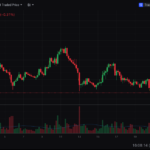The Moving Average Convergence Divergence (MACD) indicator is one of the most widely used tools in trading, celebrated for its simplicity and effectiveness. Whether you’re a seasoned trader or just starting out, a strategy based on the MACD can provide critical insights into market trends and potential trade opportunities.
In this article, we’ll dive into the essentials of the MACD, how it works, and how you can leverage it to make informed trading decisions.
What is the MACD?
The MACD is a trend-following momentum indicator that highlights the relationship between two moving averages of a security’s price. It consists of three key components:
- MACD Line: The difference between the 12-day and 26-day Exponential Moving Averages (EMA).
- Signal Line: A 9-day EMA of the MACD line, which serves as a trigger for buy and sell signals.
- Histogram: The graphical representation of the difference between the MACD line and the signal line, providing a clear visual of momentum changes.
These components together create a versatile tool for identifying trend reversals, momentum shifts, and potential entry or exit points.
Why Use the MACD?
The MACD is valued for its ability to provide both trend-following and momentum signals, making it a hybrid indicator. Here’s why traders rely on it:
- Simplicity: Easy to understand and apply across various asset classes.
- Versatility: Works well in trending and range-bound markets.
- Timely Signals: Helps identify potential trade setups before they materialize fully.
Key Trading Signals with the MACD
The MACD generates several important signals that traders can use to develop strategies:
1. Crossovers
- Bullish Crossover: When the MACD line crosses above the signal line, it indicates a potential upward price movement. This is often seen as a buy signal.
- Bearish Crossover: When the MACD line crosses below the signal line, it suggests a potential downward price movement, signaling a sell opportunity.
2. Zero Line Cross
- When the MACD line crosses above the zero line, it confirms bullish momentum.
- A cross below the zero line confirms bearish momentum.
3. Divergence
- Bullish Divergence: When the price makes lower lows, but the MACD makes higher lows, it may indicate a potential reversal to the upside.
- Bearish Divergence: When the price makes higher highs, but the MACD makes lower highs, it suggests a possible reversal to the downside.
Crafting a Strategy Based on the MACD
Here’s a step-by-step approach to building a trading strategy using the MACD:
Step 1: Identify the Trend
Use the MACD histogram and zero line to determine whether the market is in an uptrend or downtrend. Focus on long trades during uptrends and short trades during downtrends.
Step 2: Look for Crossovers
Monitor for MACD line and signal line crossovers to identify potential entry points. A bullish crossover during an uptrend is a strong signal to go long, while a bearish crossover during a downtrend signals a short opportunity.
Step 3: Confirm with Divergence
Look for divergences between the MACD and price action to confirm the strength or weakness of a trend. Divergence can provide early warning of a trend reversal.
Step 4: Set Stop-Loss and Take-Profit Levels
Define your risk parameters by setting a stop-loss level below the recent low for long trades or above the recent high for short trades. Use the MACD histogram to set take-profit levels, exiting trades when momentum weakens.
Example Trade Setup
Imagine you’re analyzing a stock that’s been in an uptrend. The MACD line crosses above the signal line, forming a bullish crossover. Simultaneously, the histogram starts to turn positive, and the MACD line crosses the zero line. You enter a long trade, setting a stop-loss below the recent swing low and targeting a profit at the next resistance level.
By following this disciplined approach, you reduce the emotional aspect of trading and increase your chances of success.
Tips for Using the MACD Effectively
- Combine with Other Indicators: Pair the MACD with volume analysis, RSI, or support and resistance levels for added confirmation.
- Avoid False Signals: In choppy markets, the MACD can give misleading signals. Use higher timeframes or additional filters to validate entries.
- Practice Makes Perfect: Backtest the strategy on historical data to understand its performance in different market conditions.
Limitations of the MACD
While the MACD is a powerful tool, it’s not without its flaws:
- Lagging Indicator: As a moving average-based tool, the MACD lags behind price action, which may lead to delayed signals.
- Whipsaws in Range-Bound Markets: The MACD can produce false signals in low-volatility markets, so it’s best used in trending environments.
To counteract these limitations, combine the MACD with other indicators or price action analysis for a more holistic approach.
Conclusion: Is the MACD Right for You?
The MACD is a versatile and reliable indicator that can enhance your trading strategy when used correctly. By mastering its signals and integrating it into your trading plan, you can make more informed decisions and increase your chances of success in the markets.
Remember, trading always carries risk. The MACD is a tool to guide your decisions, not a guarantee of success. Always practice proper risk management and consult with a financial advisor if needed.
Disclaimer: This article is for educational purposes only and does not constitute financial advice. Always conduct your own research and consider your risk tolerance before making investment decisions.







